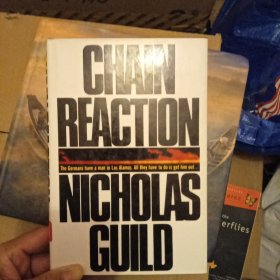
Reaction Engineering(反应工程)
¥ 120 4.0折 ¥ 298 九品
仅1件
作者李绍芬 著
出版社化学工业出版社
出版时间2019-01
版次1
装帧精装
货号中74
上书时间2024-10-01
- 最新上架
商品详情
- 品相描述:九品
- 库存书,正版,自拍实物图,无笔记勾画
图书标准信息
- 作者 李绍芬 著
- 出版社 化学工业出版社
- 出版时间 2019-01
- 版次 1
- ISBN 9787122306722
- 定价 298.00元
- 装帧 精装
- 开本 16开
- 纸张 胶版纸
- 页数 664页
- 字数 1千字
- 【内容简介】
- 本书立足于传授反应工程基本原理,并与工程实践相结合;服务于高等院校化工类专业的广大师生,工程公司的设计人员以及生产企业的工程技术人员。内容编排采用了循序渐进的方式。首先,分别介绍气固相催化反应的本征和宏观动力学,推导了间歇反应器、全混流反应器和活塞流反应器三种理想反应器的设计方程;在连续反应器流动模型的基础之上,建立起固定床、流化床和流固相非催化反应动力学及真实反应器的模型;同时,将反应器的间歇与连续、恒容与变容、绝热与换热的各种操作方式贯穿其中,并简要介绍了操作过程的多定态和定态稳定性;*后,针对生化、聚合及电化学反应工程的特点,分章加以介绍。全书共计13章,前7章可用作本科生教材,后6章可作为研究生的学习内容。全书文字叙述精炼、模型推导详尽、知识内容完整,并结合大量的例题和习题,深入浅出地传授反应工程知识,培养读者建立反应器模型和与之相关的工程设计能力。
- 【作者简介】
-
辛峰,天津大学 化工学院,系主任,教授(博士生导师),
讲授的主要课程
①、本科生必修课《化学反应工程》;
②、硕士生学位课《化学反应工程Ⅱ》;
③、博士生学位课《高等反应工程》;
④、博士生学位课《化学工程前沿》;
⑤、本科生必修课《计算机应用基础》。
主编教材
①、主编天津市“十五”规划重点教材《反应工程基础》,2001-2005;
②、主编全国工程硕士研究生教育核心教材《反应器的设计与强化》,2004-。
出版教材
①、化学工程实验,化学工业出版社,1996,参编;
②、化学反应工程习题精解,科学出版社,2003年,第二作者。
主持的教学研究课题
①、国家精品课程、天津市精品课程、天津大学精品课程《反应工程》;
②、获2003年度天津大学教学研究成果一等奖一项;
③、“新世纪高等教育教学改革工程”-“世行贷款21世纪初高等教育教学改革项目”《化工类专业创新人才培养模式、教学内容、教学方法和教学技术改革的研究与实践》项目的子项目《探索适宜培养创新人才的“化学反应工程”教学内容、方法与辅助教学技术》,子项目负责人;
④、天津大学“面向21世纪教育振兴行动计划”重点项目“反应工程课程建设”项目负责人;
⑤、天津大学“十五规划”课程-反应工程,项目负责人。
科研
①、负责国家自然科学基金“多孔介质结构表征及内扩散机理的研究” 和“超细钛硅分子筛环己酮浆态氨肟化反应动力学分析”;
②、负责中石化总公司技术开发中心发展基金“环己烷生产中反应和精馏耦合技术的开发”;
③、负责天津市自然科学基金“外场促进微乳化柴油的形成及燃烧过程分析”,“超临界条件下丙烷芳构化反应的研究”;
④、负责中石化巴陵分公司“羟氨反应系统改造研究及设计”等。
- 【目录】
-
List of Contributors xiii
Preface xv
1. Introduction 1
1.1 Chemical Reaction Engineering 1
1.2 Conversion and Yield of Chemical Reactions 4
1.2.1 Extent of Reaction 4
1.2.2 Conversion 5
1.2.3 Yield and Selectivity 7
1.3 Classifications of Chemical Reactors 10
1.4 Operation Modes of Chemical Reactors 13
1.5 Models in Reactor Design 16
1.6 Scale-Up of Industrial Reactors 19
Further Reading 22
Problems 22
2. Fundamentals of Reaction Kinetics 25
2.1 Reaction Rate 26
2.2 Reaction Rate Equations 30
2.3 Effect of Temperature on Reaction Rate 37
2.4 Multiple Reactions 44
2.4.1 Consumption Rate and Formation Rate 44
2.4.2 Basic Types of Multiple Reactions 45
2.4.3 Reaction Network 50
2.5 Transformation and Integration of Reaction Rate Equations 52
2.5.1 Single Reaction 52
2.5.2 Multiple Reactions 57
2.6 Heterogeneous Catalysis and Adsorption 60
2.6.1 Heterogeneous Catalysis 61
2.6.2 Adsorption and Desorption 62
2.7 Kinetics of Heterogeneous Catalytic Reactions 67
2.7.1 Steady-State Approximation and Rate-Determining Step 68
2.7.2 Rate Equations of Heterogeneous Catalytic Reactions 70
2.8 Determination of Kinetic Parameters 77
2.8.1 Integration Method 77
2.8.2 Differential Method 79
2.9 Procedure for Developing Reaction Rate Equation 86
Further Reading 87
Problems 88
3. Tank Reactor 95
3.1 Mass Balance for Tank Reactor 96
3.2 Design of Isothermal Batch Tank Reactor(Single Reaction) 97
3.2.1 Calculation of Reaction Time and Reaction Volume 98
3.2.2 Optimal Reaction Time 102
3.3 Design of Isothermal Batch Tank Reactor (Multiple Reactions) 103
3.3.1 Parallel Reactions 103
3.3.2 Consecutive Reactions 107
3.4 Reactor Volume for Continuous Tank Reactor (CSTR) 111
3.5 CSTR in Series and Parallel 115
3.5.1 Overview 115
3.5.2 Calculations for Multiple Reactors in Series 117
3.5.3 Optimal Reaction Volume Ratio for CSTR in Series 122
3.6 Yield and Selectivity for Multiple Reactions in a Tank Reactor 123
3.6.1 Overall Yield and Overall Selectivity 124
3.6.2 Parallel Reactions 125
3.6.3 Consecutive Reactions 129
3.7 Semibatch Tank Reactor 133
3.8 Nonisothermal Batch Reactor 138
3.9 Steady-State Operation of CSTR 145
3.9.1 Heat Balance for CSTR 145
3.9.2 Steady-States of CSTR 147
Summary 151
Further Reading 152
Problems 153
4. Tubular Reactor 161
4.1 Plug Flow 161
4.2 Design of Isothermal Tubular Reactor 163
4.2.1 Single Reaction 164
4.2.2 Multiple Reactions 168
4.2.3 Pseudo Homogeneous Model 176
4.3 Comparison of Reactor Volumes of Tubular and Tank Reactors 178
4.4 Recycle Reactor 184
4.5 Nonisothermal Tubular Reactor 185
4.5.1 Heat Balance Equation for Tubular Reactor 186
4.5.2 Adiabatic Tubular Reactor 188
4.5.3 Nonadiabatic Nonisothermal Tubular Reactor 193
4.6 Optimal Temperature Sequence for Tubular Reactors 197
4.6.1 Single Reaction 198
4.6.2 Multiple Reactions 200
Further Reading 203
Problems 203
5. Residence Time Distribution and Flow Models for Reactors 213
5.1 Residence Time Distribution 214
5.1.1 Overview 214
5.1.2 Quantitative Delineation of RTD 215
5.2 Experimental Determination of RTD 218
5.2.1 Pulse Experiments 219
5.2.2 Step Experiments 221
5.3 Statistical Eigenvalues of RTD 224
5.4 RTD of Ideal Reactors 228
5.4.1 Plug-Flow Model 228
5.4.2 Perfectly-Mixed Flow Model 230
5.5 Nonideal Flow Phenomenon 234
5.6 Nonideal Flow Models 238
5.6.1 Segregation Model 238
5.6.2 Tanks-in-Series Model 242
5.6.3 Axial Dispersion Model 247
5.7 Design of Nonideal Reactors 251
5.8 Mixing of Fluids in Flow Reactors 256
Further Reading 260
Problems 261
6. Chemical Reaction and Transport Phenomena in Heterogeneous System 265
6.1 Steps in Heterogeneous Reactions 266
6.1.1 Macroscopic Structures and Properties of Solid Catalyst Particles 266
6.1.2 Steps in a Catalytic Reaction 269
6.2 Heat and Mass Transfer Between Bulk Fluid and the Catalyst External Surface
270
6.2.1 Transport Coefficient 270
6.2.2 Concentration and Temperature Difference Between the External Surface of
Catalyst and Bulk Fluid 272
6.2.3 Effect of External Diffusion on Heterogeneous Catalytic Reactions 275
6.3 Gas Diffusion in Porous Media 279
6.3.1 Diffusion in Pores 279
6.3.2 Diffusion in Porous Particles 280
6.4 Diffusion and Reaction in Porous Catalysts 281
6.4.1 Reactant Concentration Profile in Porous Catalysts 282
6.4.2 Internal Effectiveness Factor 285
6.4.3 Internal Effectiveness Factor for Non-first Order Reactions 290
6.4.4 Effectiveness Factor Under the Influences of Both Internal and External
Diffusions 292
6.5 Effect of Internal Diffusion on Selectivity of Multiple Reactions 294
6.6 Determination of Diffusion Impact on Heterogeneous Reactions 297
6.6.1 Determination of the Effects of External Diffusion 297
6.6.2 Determining the Effects of Internal Diffusion 299
6.7 Effects of Diffusion on Experimental Measurement of Reaction Rate 301
Further Reading 305
Problems 306
7. Analysis and Design of Heterogeneous Catalytic Reactors 311
7.1 Transport Phenomena Inside Fixed Bed Reactors 312
7.1.1 Fluid Flow Inside a Fixed Bed 312
7.1.2 Mass and Heat Dispersion Along Axial Direction 316
7.1.3 Mass and Heat Transfer in Radial Direction 317
7.2 Mathematical Model for Fixed Bed Reactor 320
7.3 Adiabatic Fixed Bed Reactor 325
7.3.1 Adiabatic Reactors 325
7.3.2 Catalyst Volume for Adiabatic Fixed Bed Reactor 327
7.3.3 Multistage Adiabatic Reactors 331
7.4 Fixed Bed Reactor With Internal Heat Exchanger 337
7.4.1 Overview 337
7.4.2 Analysis for Single Reaction 339
7.4.3 Analysis of Multiple Reaction Systems 342
7.5 Autothermal Fixed Bed Reactors 347
7.5.1 Feed Flow Direction 348
7.5.2 Mathematical Model 349
7.6 Parameter Sensitivity 351
7.7 Laboratory Catalytic Reactor 355
7.7.1 Basic Requirements 355
7.7.2 Main Types of Experimental Reactor 357
Further Reading 361
Problems 361
8. Fluidized Bed Reactor 369
8.1 Introduction 369
8.2 Fluidization 369
8.2.1 Fluidization Phenomenon 369
8.2.2 Particle Classifications 370
8.2.3 Fluidization Parameters 371
8.2.4 Fluidization Regimes 375
8.3 Bubbling Fluidized Bed 376
8.3.1 Bubble Behaviors 377
8.3.2 Mathematical Model of Bubbling Fluidized Bed 380
8.4 Turbulent Fluidized Bed 388
8.4.1 Regime Transition 388
8.4.2 Hydrodynamic Characteristics 389
8.5 Circulating Fluidized Bed 389
8.5.1 Introduction 389
8.5.2 Configuration of CFB 391
8.5.3 Mathematical Models of CFB 392
8.6 Downer Reactor 398
Further Reading 401
Problems 402
9. Multiple-Phase Reactors 405
9.1 Gas-Liquid Reactions 405
9.1.1 Pseudo First Order Reaction 408
9.2 Gas-Liquid Reactors 412
9.2.1 Main Types of Reactors 412
9.2.2 Design of Bubble Column Reactor 414
9.2.3 Design of Stirred Tank Reactor 419
9.3 Gas-Liquid-Solid Reactions 421
9.3.1 Introduction 421
9.3.2 Mass Transfer Steps and Rates in Gas-Solid-Liquid Catalytic Reactions 422
9.4 Trickle Bed Reactors 425
9.4.1 Introduction 425
9.4.2 Mathematical Model 427
9.5 Slurry Reactor 431
9.5.1 Types of Reactors 431
9.5.2 Mass Transfer and Reaction 432
9.5.3 Design of Mechanically Stirred Slurry Tank Reactor 437
Further Reading 441
Problems 441
10. Fluid-Solid Noncatalytic Reaction Kinetics and Reactors 445
10.1 Fluid-Solid Noncatalytic Reactions and Their Applications 446
10.2 Reaction Rate of Particles in Different Shapes 448
10.3 Theoretical Models of Solid Reactions 451
10.4 Kinetic Analysis of Continuous Model 452
10.5 Kinetic Analysis at Constant Particle Size Using the Shrinking Core Model
454
10.5.1 Overall Macroreaction Rate 456
10.5.2 Macroreaction Rate Under Internal Diffusion Control 459
10.5.3 Macroreaction Rate Under External Diffusion Control 460
10.5.4 Intrinsic Reaction Rate Under Surface Reaction Control 461
10.5.5 Comparison and Differentiation of Rate-Controlling Steps at Constant
Particle Size 463
10.6 Kinetic Analysis With Changing Particle Diameter Using the Shrinking Core
Model 466
10.6.1 Internal Diffusion Control 469
10.6.2 External Diffusion Control 470
10.6.3 Chemical Reaction Control 471
10.6.4 Overall Reaction Time 473
10.7 Microparticle Model 473
10.8 Chemical Vapor Deposition 477
10.9 Design of Fluid-Solid Noncatalytic Reactor 479
10.9.1 Reactor Types 480
10.9.2 Flowing and Mixing of Reaction Components 480
10.9.3 Reactor Design When Fluid Is a Complete Mixing Flow and Solid Phase Is a
Plug Flow 483
10.9.4 Reactor Design When Fluid and Solid Phases Can Be Treated as Complete
Mixing Flow 484
Further Reading 487
Problems 487
11. Fundamentals of Biochemical Reaction Engineering 491
11.1 Introduction 491
11.2 Fundamentals of Biochemical Reaction Kinetics 494
11.2.1 Enzyme-Catalyzed Reactions and Its Kinetics 494
11.2.2 Kinetics of Microbial Reactions 507
11.3 Immobilized Biocatalysts 513
11.3.1 Introduction 513
11.3.2 Enzyme and Cell Immobilization 514
11.3.3 Catalytic Kinetics of Immobilized Biocatalyst 517
11.4 Bioreactors 521
11.4.1 Types of Bioreactors 522
11.4.2 Bioreactor Calculations 527
Reference 536
Further Reading 536
Problems 536
12. Fundamentals of Polymerization Reaction Engineering 541
12.1 Overview 542
12.2 Kinetic Analysis 544
12.2.1 Types of Polymerization Reaction 544
12.2.2 Degree of Polymerization and Distribution 545
12.2.3 Homogeneous Free Radical Polymerization Reaction 553
12.2.4 Polycondensation Reaction 576
12.2.5 Factors That Influence Polymerization Rate 582
12.3 Analysis of Heat and Mass Transfers in the Polymerization Process 585
12.3.1 Thermal Effect in Polymerization Process 585
12.3.2 Heat Transfer and Fluid Flow in Polymerization Process 587
12.3.3 Heat and Mass Transfer Coefficients 589
12.4 Design and Analysis of Polymerization Reactor 589
12.4.1 Polymerization Reactor and Agitator 589
12.4.2 Mathematical Model 590
12.4.3 Calculation and Analysis of Polymerization Reactors 591
References 596
Further Reading 596
Problems 597
13. Introduction to Electrochemical Reaction Engineering 599
13.1 Introduction 599
13.1.1 Characters of Electrochemical Reactions 599
13.1.2 Performance Parameters for Electrochemical Reaction Engineering 601
13.2 Special Issues in Electrochemical Reaction Engineering 608
13.2.1 Electrical Potential and Current Distribution on Electrode Surface 608
13.2.2 Effects of Gassing 618
13.2.3 Mass Transfer in Electrochemical Engineering 622
13.2.4 Heat Transfer and Balance in Electrochemical Engineering 625
13.3 Electrochemical Reactors 629
13.3.1 Types of Electrochemical Reactors 630
13.3.2 Operation Characters of Electrochemical Reactors 633
13.3.3 Connections and Combination of Electrochemical Reactors 645
References 651
Further Reading 651
Problems 651
Index 653
相关推荐
-

REACTION
八五品衡水
¥ 50.00
-

REACTION
九品天津
¥ 48.00
-

GUT REACTION
八五品淮安
¥ 6.00
-

chain reaction
九品廊坊
¥ 150.00
-

Reaction Engineering
九五品上海
¥ 141.13
-

Reaction Engineering
九五品南京
¥ 139.13
-

LA REACTION
八五品上海
¥ 739.90
-

chain reaction
八五品衡水
¥ 24.00
-

ELEMENTARY REACTION KINETICS
八五品衡水
¥ 20.00
-

Polymer Reaction Engineering
九品北京
¥ 400.00
— 没有更多了 —

















以下为对购买帮助不大的评价